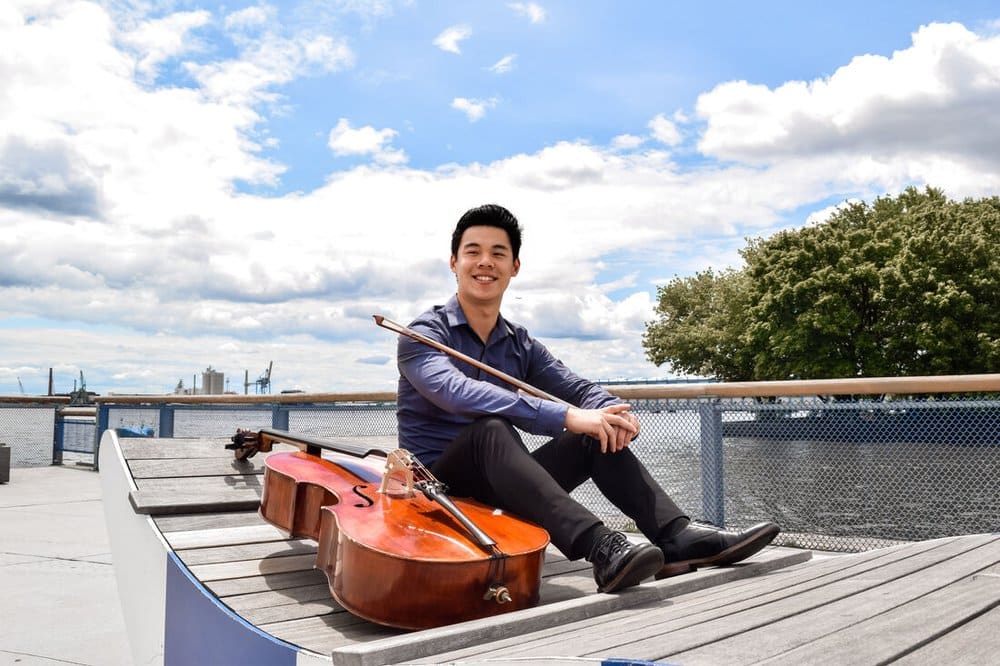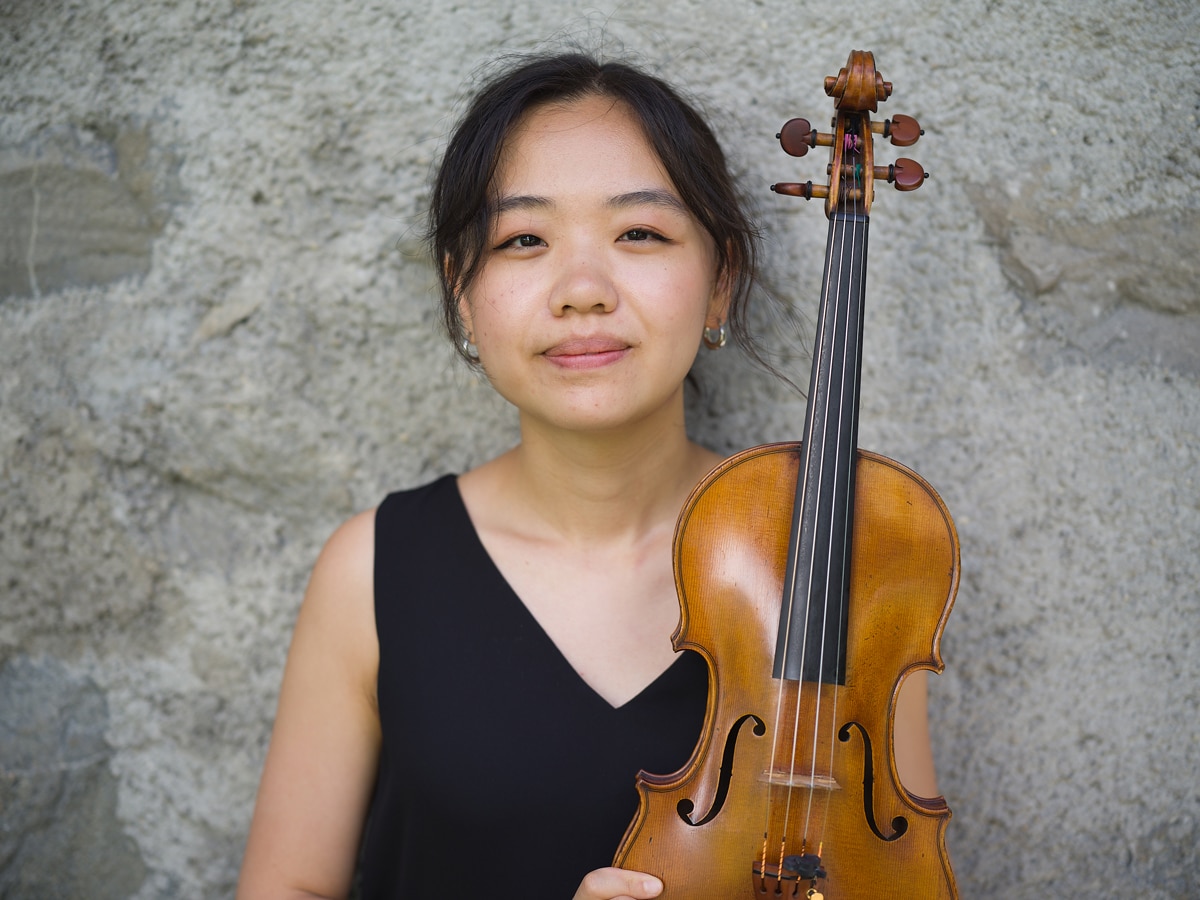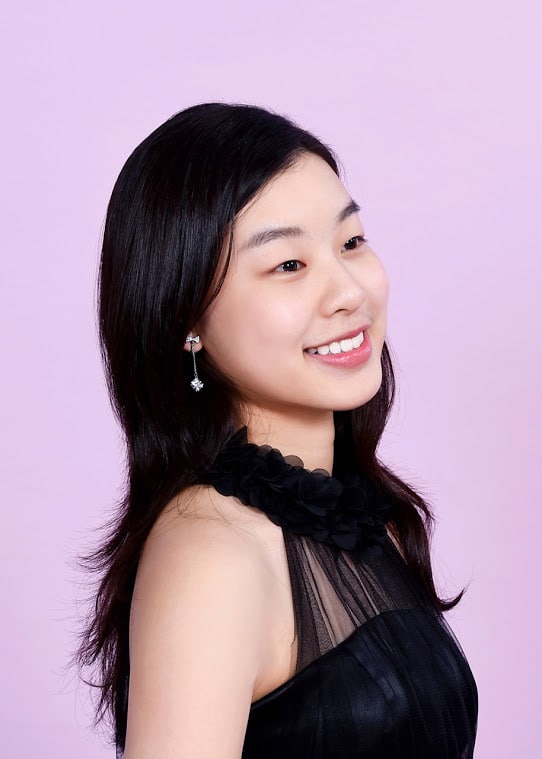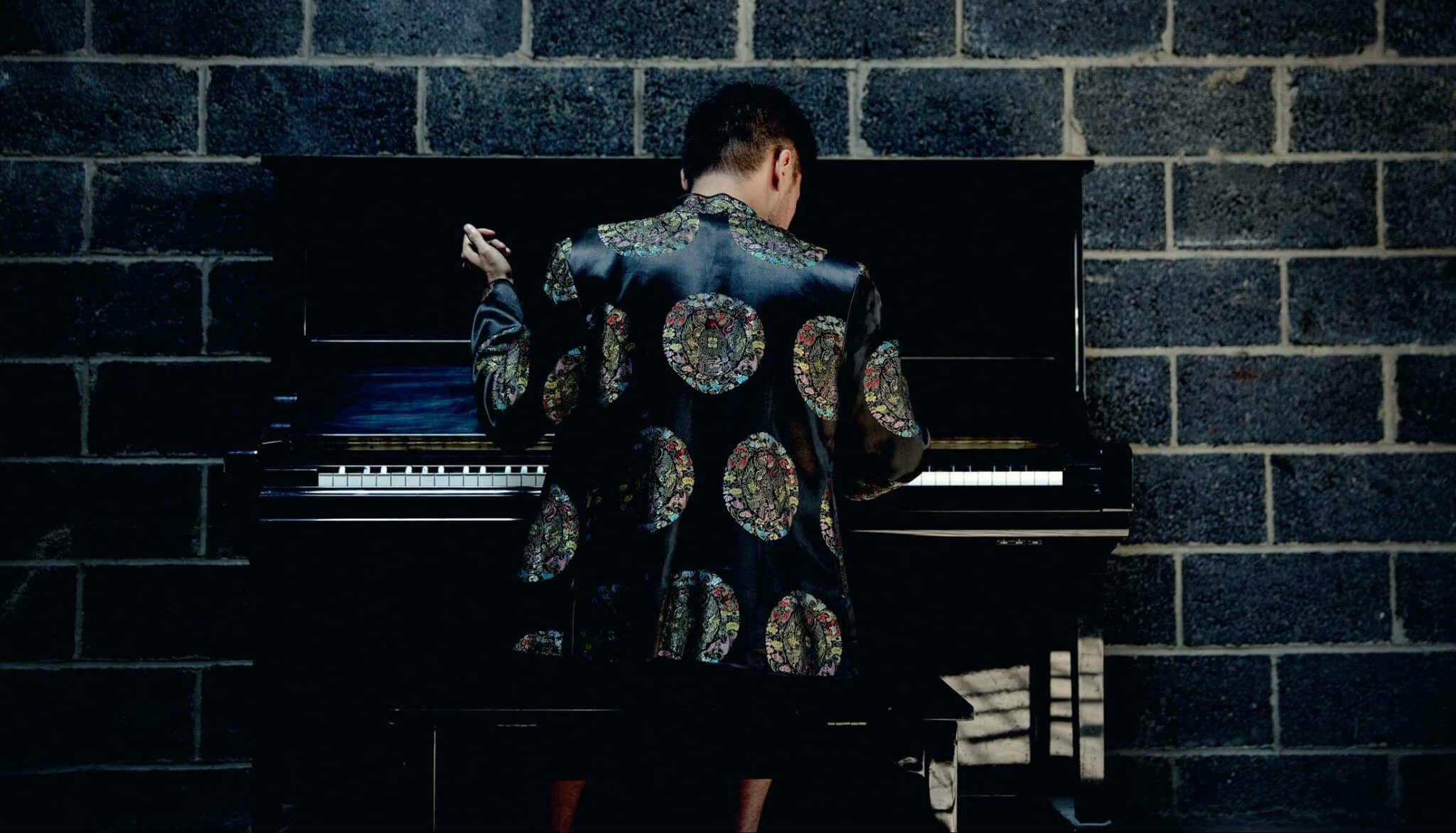Please enjoy the program notes for tonight’s Mosher Guest Artist Recital with Conrad Tao. These program notes were created as part of Project Resonance, the Music Academy’s unique program combining writing training with public engagement. Through this initiative, both Academy fellows and young scholars from UC Santa Barbara are given the opportunity to work on program notes and other written materials for the Summer Festival.
***
JOHN ADAMS China Gates
Today, John Adams is 74 years old, and a venerated master among living composers. In 1977, though, by his own admission, he was just finally coming into his compositional voice at age 30 with China Gates.
During Adams’s studies at Harvard he had fervently espoused the virtues of the highly dissonant and complex modernist style of the time, but a contradiction loomed between his academic approach towards music and the records he listened to in his spare time, like those of The Beatles and Jimi Hendrix. During his last semester at Harvard, six years prior to China Gates, a fellow composition student invited Adams over to listen to a recording of a new work by Terry Riley: In C–a work consisting of a constant pulse on the note C and 53 short musical gestures which an indeterminate group of instrumentalists plays through at any pace they choose, repeating each gesture ad nauseum before moving on to the next one. This creates a musical arc which begins quite simply and then increases in rhythmic complexity and dissonance, but the details of that arc vary from performance to performance. This kind of randomized gesture approach came to characterize many more works of what became known as minimalism. Adams later recounts in his autobiography:
“In C captured the congenital hippie spirit of the West Coast while at the same time proposing a new, slowly evolving approach to musical form. It was also marvelously provocative, giving an R. Crumb middle finger to the crabbed, pedantic world of academic modernism.”
Something about that West Coast spirit captured Adams’ affection, and upon graduation he drove his decrepit Volkswagen Beetle across the country to San Francisco.
The vacuum left by Adams’s increasing disillusionment with modernism was not, however, immediately filled by the minimalist style which had been ushered in by works like In C. Throughout his early years in San Francisco, Adams made his living teaching and directing the New Music Ensemble at the San Francisco Conservatory, but was adrift when it came to his own composition. While Adams embraced the new harmonic language and slowly evolving forms of minimalism, he lamented the loss of precision and counterpoint that arose from their improvisational elements. Enter: Steve Reich.
Adams heard Steve Reich’s ensemble perform his piece Drumming in 1974 and was immediately inspired to program another of Reich’s works with the conservatory New Music Ensemble, giving him an inside look at this rigorously composed form of minimalism. It was at this point that the wheels started to turn for Adams’ mature style. Over the next couple of years he honed and toyed with these ideas inspired by Riley and Reich. Although some of his new works in this style received performances, they had not yet reached the level of precision he was seeking. His work finally came to fruition with a commission from the San Francisco Conservatory for a large-scale piano work to be premiered by piano professor Mack McCray. During the compositional process for what eventually became Phrygian Gates, Adams completed a miniaturized version–China Gates–for a student at the conservatory named Sarah Cahill. Adams explores a similar harmonic landscape to many minimalist pieces which came before, but with precisely notated control of interesting dissonances and powerful bass notes which punctuate just the right moments. From his first childhood compositions at age 10, Adams had taken 20 years to find his voice with China Gates. This modest five-minute work, premiered by a student over a decade younger than himself, was an unexpected milestone in the career of one of our greatest living composers.
– Logan Bryck, Academy fellow, horn
JASON ECKHARDT Echoes’ White Veil Would you do me a favor? Tonight after this concert, take a moment to look up at the night sky. Maybe with binoculars, or even a telescope. A canopy of thousands of tiny points of light gleam, the stars unfurled above us in the heavens. The fact that we can see them at all is both a wonder of physics and a happy accident of our time and place in the universe. With their fancy space telescopes, astronomers can peer across seemingly incomprehensible distances. Discovered in 2016 and confirmed in late 2020, GN-z11 holds the record for the most distant galaxy ever observed, its light reaching us from 13.4 billion light-years away. But to look so far away is also to look into the distant past. Of course, you or I could never see GN-z11, hard as we might look for it, scouring the skies with even the most powerful ground-based telescopes. Yet if somehow we were to spy its grungy, dim image—there! just above the handle of the Big Dipper, can you make it out?—we would be seeing it as it was 13.4 billion years ago. We may imagine light travels tremendously fast, even instantaneously, but light is no match for the incomprehensible scale of our universe. Indeed, when the light currently reaching our eyes first left the newborn stars and glowing dust-clouds of GN-z11, scarcely 500 million years had elapsed since the Big Bang: the very dawn of the universe. Advanced civilizations might have evolved, developed rich and unique cultures, explored and colonized their galaxy, and then passed into oblivion. More than once. And terrifyingly, the cosmos is becoming more inaccessible with every passing moment. The universe is expanding at an accelerating pace; the current, actual distance of GN-z11 is estimated at some 32 million light-years. Eventually, the universe will expand at such a rate that the space between us and distant galaxies increases faster than light can traverse it; at this point, they will slip behind the cosmological horizon and be lost forever. What we see now are but ghosts, echoes of the hopeful past stumbling into an uncertain future.
JASON ECKHARDT Echoes’ White Veil Would you do me a favor? Tonight after this concert, take a moment to look up at the night sky. Maybe with binoculars, or even a telescope. A canopy of thousands of tiny points of light gleam, the stars unfurled above us in the heavens. The fact that we can see them at all is both a wonder of physics and a happy accident of our time and place in the universe. With their fancy space telescopes, astronomers can peer across seemingly incomprehensible distances. Discovered in 2016 and confirmed in late 2020, GN-z11 holds the record for the most distant galaxy ever observed, its light reaching us from 13.4 billion light-years away. But to look so far away is also to look into the distant past. Of course, you or I could never see GN-z11, hard as we might look for it, scouring the skies with even the most powerful ground-based telescopes. Yet if somehow we were to spy its grungy, dim image—there! just above the handle of the Big Dipper, can you make it out?—we would be seeing it as it was 13.4 billion years ago. We may imagine light travels tremendously fast, even instantaneously, but light is no match for the incomprehensible scale of our universe. Indeed, when the light currently reaching our eyes first left the newborn stars and glowing dust-clouds of GN-z11, scarcely 500 million years had elapsed since the Big Bang: the very dawn of the universe. Advanced civilizations might have evolved, developed rich and unique cultures, explored and colonized their galaxy, and then passed into oblivion. More than once. And terrifyingly, the cosmos is becoming more inaccessible with every passing moment. The universe is expanding at an accelerating pace; the current, actual distance of GN-z11 is estimated at some 32 million light-years. Eventually, the universe will expand at such a rate that the space between us and distant galaxies increases faster than light can traverse it; at this point, they will slip behind the cosmological horizon and be lost forever. What we see now are but ghosts, echoes of the hopeful past stumbling into an uncertain future.
These ideas of temporality and the confluence of past, present, and future undergird American composer Jason Eckardt’s Echoes’ White Veil. Originally written for pianist and champion of contemporary music Marilyn Nonken, the piece juxtaposes silence against various complex textures, deriving inspiration from a prose poem by W. S. Merwin:
“Everything we hear is an echo. Anyone can see that echoes move forward and backward in time, in rings. But not everyone realizes that as a result silence becomes harder and harder for us to grasp, though in itself it is unchanged, because of the echoes pouring through us out of the past, unless we can learn to set them at rest…
“So we know that there are words in the future, some of them loud and terrible. And we know that there is silence in the future. But will the words recognize their unchanging homeland?”
Over the course of eleven minutes of fiendishly difficult piano writing, you might have any of a number of reactions. Admiration for Conrad Tao’s virtuosity, most definitely. Puzzlement over the structure and organization of the piece, perhaps. Try listening to the silences; what do you hear in them? Try looking for the shapes; what color are they?
Perhaps you might imagine this piece as some sort of sound-tesseract. (A tesseract is not just a fun word to say, nor a plot contrivance in a summer blockbuster, but a real mathematical term for a four-dimensional cube!) In the portion of W. S. Merwin’s poem that inspired the title of this piece, Merwin describes how a sound looks:
“I see the sound appear running away from me over the water in her white veil, growing taller, becoming a cloud with raised arms, in the dusk. Then there is such silence that the trees are bent. And afterwards a shock like wind, that throws me back against the hill…”
Music exists exclusively as a temporal entity, in contrast to other forms of art such as painting or literature. You can point to a portrait or a novel and say “look, here is art.” But you can only experience music embedded within time, our fourth dimension. If this piece were presenting you with cross-sections of a larger four-dimensional structure—as you can cross-section a cube into squares or a tesseract into cubes—what would the whole thing look like? Would it appear as Merwin describes it?
Rays of light from distant galaxies sojourning across the void, vibrations of a single piano note reverberating and decaying into silence—these things remind us of how deeply special and precious this very moment is. That we are here, together, capable of experiencing beauty in an unimaginably exquisite universe. Let us endeavor, as Merwin and Eckardt suggest, to set the echoes of past and future to rest and grasp the silence once more.
– Zerek Dodson, Academy fellow, collaborative piano
ROBERT SCHUMANN Kreisleriana In the words of Friedrich Nietzche, “There is always some madness in love -” but for Robert Schumann, there was love in madness. The German composer likely had what we now know as bipolar disorder, a manic-depressive illness often accompanied by unusual intelligence and creativity. The love in his life was Clara Wieck, the daughter of his piano teacher with whom he lived for over ten years. The young couple became engaged in 1837 but Clara’s father objected, forcing them to delay their marriage and even petition the courts. It was during this tumultuous time that Schumann wrote Kreisleriana Op. 16 for solo piano – inspired by the writings of E.T.A. Hoffmann.
ROBERT SCHUMANN Kreisleriana In the words of Friedrich Nietzche, “There is always some madness in love -” but for Robert Schumann, there was love in madness. The German composer likely had what we now know as bipolar disorder, a manic-depressive illness often accompanied by unusual intelligence and creativity. The love in his life was Clara Wieck, the daughter of his piano teacher with whom he lived for over ten years. The young couple became engaged in 1837 but Clara’s father objected, forcing them to delay their marriage and even petition the courts. It was during this tumultuous time that Schumann wrote Kreisleriana Op. 16 for solo piano – inspired by the writings of E.T.A. Hoffmann.
Schumann wrote in his diary “One can hardly breathe when one reads Hoffmann,” so it is no surprise that three of his song cycles were directly based on Hoffmann’s writings. The title Kreisleriana comes directly from a chapter in Hoffmann’s Fantasy Pieces in Callot’s Manor, and Hoffmann’s satirical novel, The Life and Opinions of a Tomcat Murr inspired Schumann’s compositional style. This eight movement piano fantasia mimics the duality of Tomcat Murr, a story in which a printer error causes the memoir of the Tomcat Murr to be mixed up with the biography of Hoffmann’s iconic character, composer Johannes Kreisler. Tomcat Murr ostensibly tells the bildungsroman of a cat, but in actuality, the focus is on Kreisler, Hoffmann’s mad-genius character who was obsessed with the idea that madness lay in wait for him. Just as Tomcat Murr alternates between starkly different storylines, the eight movements in Kreisleriana alternate home keys. The piece begins in the key of D minor and ends in G minor, but is sprinkled throughout with slow, lyrical movements in Bb major.
As a celebrity concert pianist and composer, Clara Wieck championed the works of Robert Schumann, who was ostracized and unpopular as a composer during his lifetime. In fact, after Schumann died in an asylum years later, Clara stopped composing her own works to focus on securing her late husband’s legacy. Clara and Robert were inseparable, both in life and in music. Clara Wieck only published 23 works of her own, but it is impossible to know how many pieces of Schumann’s were influenced or even partially written by Wieck. Robert folded many of Clara’s compositions into his own works in a sort of secret language with his love- especially during the time when Clara’s father had forbidden their marriage. Kreisleriana is no exception. Robert wrote in his letters to Clara:
“I’m overflowing with music and beautiful melodies now – imagine, since my last letter I’ve finished another whole notebook of new pieces. I intend to call it Kreisleriana. You and one of your ideas play the main role in it, and I want to dedicate it to you – yes, to you and nobody else – and then you will smile so sweetly when you discover yourself in it.”
Robert used Clara’s writing as a theme in Kreisleriana. He wished to dedicate the piece to her but was unable to because of Mr. Wieck’s disapproval. Instead, he dedicated the piece to Frédéric Chopin, who had no appreciation for it. Upon receipt of the manuscript, Chopin remarked only on the design of the cover page.
Schumann remarked, “Kreisler is one of E. T. A. Hoffmann’s creations, an eccentric, wild, and witty conductor,” and he later wrote to Clara, “Play my Kreisleriana sometimes! There’s a very wild love in a few movements, and your life, and mine and many of your looks.” Schumann’s use of the word “wild” to describe both Clara and Kreisler, as well as his fascination with the Kreisler character, points to an eerie foreshadowing of the bipolar episode that would ultimately end both his and Clara’s careers.
– Cristina Cutts Dougherty, Academy fellow, tuba
[big-cast]





